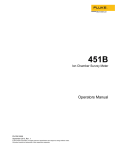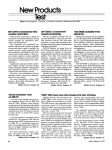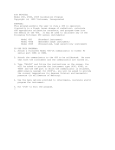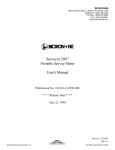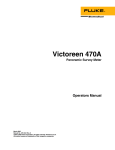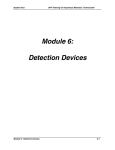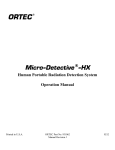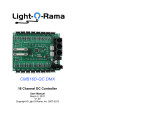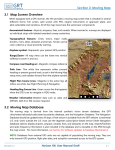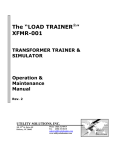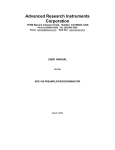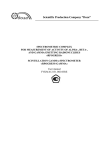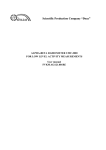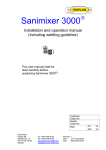Download Micro-Analyst Micro R Survey Meter User`s Manual
Transcript
BICRON‚NE 6801 Cochran Road ! Solon, Ohio 44139 USA Telephone: (440) 248-7400 Toll Free: (800) 472-5656 Fax: (440) 349-6581 http://www.bicron.com Micro-AnalystTM Micro R Survey Meter User's Manual Publication No. 1019-0-U-1198-002 * * * Release Date * * * November 20, 1998 Part No. 1019900 Rev. C Saint-Gobain Industrial Ceramics, Inc. ISO 9001 Quality System Certified Publication Number: 1019-0-U-1198-002 Part No. 1019900, Rev. C Replaces and supersedes: 1019-0-U-1297-001 Part No. 1019900, Rev. B Original Issue: July 1984 NOTICE BICRON‚NE reserves the right to make changes to any product to improve reliability, function or design and does not assume any liability arising from either application or use of any product or circuit described herein. Information presented in this publication has been carefully checked and is believed to be entirely reliable; however, no responsibility is assumed for inaccuracies. Furthermore, the information does not convey to the user any license under the patent rights of BICRON‚NE or others. Specifications subject to change without notice. LIMITED RIGHTS LEGEND The data in this manual is considered "proprietary data". It may be duplicated and used by or on behalf of the customer with the express limitations the "proprietary data" may not be disclosed outside the customer or be used for purposes of manufacture without prior permission of the seller. This legend shall be marked on any reproduction of this data in whole or in part. (C) Copyright Saint-Gobain Industrial Ceramics, Inc., 1998 All rights reserved Printed in U.S.A. Micro-Analyst Micro R Survey Meter 1019-0-U-1198 Page 1 User's Manual FOREWORD This manual provides the basic installation, operation, and maintenance procedures for the Bicron Micro-AnalystTM Micro R Survey Meter. Section 1.0 Introduction provides a general description of the instrument and its operation, and a detailed listing of its physical and performance specifications. Section 2.0 Battery describes the procedure for installing and testing the batteries. Section 3.0 Operational Modes describes the FR/h and SCA operating modes of the instrument. Section 4.0 Setup describes the useradjustable controls for the SCA mode. Section 5.0 Radiation Measurements describes how to measure radiation. Section 6.0 Audio describes the function and control of the internal speaker. Section 7.0 Selectable Response Time describes how to tailor response times to specific survey situations. Section 8.0 Circuit Description provides a brief description of the four major components of the instrument's electronic circuitry. Section 9.0 Calibration provides directions for calibration of the instrument. The Appendices are: A) QC Acceptance Procedure, which includes calibration procedures, B) a Suggested Spare Parts List, C) a complete Parts List so the instrument can be repaired on-site, and D) schematic and pictorial drawings to facilitate repair procedures. Micro-Analyst Micro R Survey Meter Page 2 1019-0-U-1198 User's Manual FOREWORD (cont'd) In order to maintain consistency throughout this and all BICRON‚NE manuals, certain writing conventions have been followed for safety warnings. They are divided into three categories and defined as follows: The definition of these safety warnings is according to ANSI Z535.4. The style of the warnings (bold, italicized, etc.) is BICRON‚NE's. In addition to the above, we have added the following warning: ! DANGER indicates an imminently hazardous situation which, if not avoided, will result in death or serious injury. DANGER NOTICES ALWAYS APPEAR IN BOLD, ITALICIZED UPPER CASE LETTERS. ! ! WARNING indicates a potentially hazardous situation which, if not avoided, could result in death or serious injury. WARNING NOTICES ALWAYS APPEAR IN UPPERCASE BOLD LETTERS. ! CAUTION indicates a potentially hazardous situation which, if not avoided, may result in minor or moderate injury. It may also be used to alert against unsafe practices. CAUTION notices always appear in bold, italicized letters. NOTE indicates a situation which has the potential for erroneous data collection, or damage to equipment, but which does not directly affect the safety of the operator with respect to this product. The responsibility for any safety consequences as a result of erroneous data lies solely with the operator. NOTE notices always appear in italics. Micro-Analyst Micro R Survey Meter 1019-0-U-1198 Page 3 User's Manual TABLE OF CONTENTS Section Page Standard Warranty / Exclusion of Warranty . . . . . . . . . . . . . . . . 5 Procedures and Cautions . . . . . . . . . . . . . . . . . . . . . . . . . . . . . . 6 1.0 Introduction 1.1 General Description . . . . . . . . . . . . . . . . . . . . . . . . . . . . . . . 7 1.2 Specifications . . . . . . . . . . . . . . . . . . . . . . . . . . . . . . . . . . . 7 2.0 Battery 2.1 Type . . . . . . . . . . . . . . . . . . . . . . . . . . . . . . . . . . . . . . . . . . 2.2 Replacement Procedure . . . . . . . . . . . . . . . . . . . . . . . . . . . . 2.3 Safety Practices 2.3.1 Battery Test . . . . . . . . . . . . . . . . . . . . . . . . . . . . . . . . . . . 2.3.2 High Voltage Measurement . . . . . . . . . . . . . . . . . . . . . . . 8 8 8 8 3.0 Operational Modes . . . . . . . . . . . . . . . . . . . . . . . . . . . . . . 9 4.0 Setup . . . . . . . . . . . . . . . . . . . . . . . . . . . . . . . . . . . . . . . . . 9 4.1 Lower-Level Discriminator . . . . . . . . . . . . . . . . . . . . . . . . . 9 4.2 Window . . . . . . . . . . . . . . . . . . . . . . . . . . . . . . . . . . . . . . . . 9 4.3 HV Adjustment . . . . . . . . . . . . . . . . . . . . . . . . . . . . . . . . . . 10 5.0 Radiation Measurements . . . . . . . . . . . . . . . . . . . . . . . . . 10 6.0 Audio . . . . . . . . . . . . . . . . . . . . . . . . . . . . . . . . . . . . . . . . . 10 7.0 Selectable Response Time . . . . . . . . . . . . . . . . . . . . . . . . . 11 8.0 Circuit Description . . . . . . . . . . . . . . . . . . . . . . . . . . . . . . 11 9.0 Calibration . . . . . . . . . . . . . . . . . . . . . . . . . . . . . . . . . . . . . 11 Appendices Appendix Page A QC Acceptance Procedure, Number 1019937 . . . . . . . A-1 B Suggested Spare Parts List . . . . . . . . . . . . . . . . . . . . . . A-5 C Parts List, Number 1019910 . . . . . . . . . . . . . . . . . . . . A-7 D Drawings . . . . . . . . . . . . . . . . . . . . . . . . . . . . . . . . . . . A-9 Micro-Analyst Micro R Survey Meter Page 4 1019-0-U-1198 User's Manual BLANK PAGE Micro-Analyst Micro R Survey Meter 1019-0-U-1198 Page 5 User's Manual BICRON‚ ‚NE WARRANTY STATEMENT COVERING PORTABLE MONITORS Instruments and options manufactured by BICRON‚NE are warranted against defects in materials and workmanship for a period of two years from the date of shipment, unless otherwise agreed upon by BICRON‚NE and the customer in writing. BICRON‚NE's obligation with regard to such products shall be limited to repair or replacement FOB BICRON‚NE factory or authorized repair station, at BICRON‚NE's option. The calibration (when applicable) for each system is warranted to be within its specified accuracy at the time of shipment. If this initial calibration is determined to be in error, the system will be recalibrated at no charge. The aforesaid warranty does not cover systems, options or probes which are subject to excessive physical abuse or are used for purposes other than those intended. In no event shall BICRON‚NE be liable for consequential or special damages, transportation, installation, adjustment, work done by customer, or other expenses which may arise in connection with such defective product or parts. EXCLUSION OF LIMITED WARRANTY THERE ARE NO WARRANTIES, EXPRESS OR IMPLIED, INCLUDING WITHOUT LIMITATION ANY IMPLIED WARRANTY OF MERCHANTABILITY OR FITNESS, WHICH EXTEND BEYOND THE DESCRIPTION ON THE FACE HEREOF. THIS EXPRESS WARRANTY EXCLUDES COVERAGE OF, AND DOES NOT PROVIDE RELIEF FOR, INCIDENTAL OR CONSEQUENTIAL DAMAGES OF ANY KIND OR NATURE, INCLUDING, BUT NOT LIMITED TO, LOSS OF USE, LOSS OF SALES OR INCONVENIENCE. THE EXCLUSIVE REMEDY OF THE PURCHASER IS LIMITED TO REPAIR, RECALIBRATION, OR REPLACEMENT OF THE SYSTEM AT BICRON‚NE's OPTION. This warranty specifically excludes the following items which are covered by their original manufacturers' warranties: photomultiplier tubes, GM and proportional tubes, crystal and other solidstate detectors and batteries. Micro-Analyst Micro R Survey Meter Page 6 1019-0-U-1198 User's Manual PROCEDURES and CAUTIONS The equipment herein described is designed and manufactured in compliance with all applicable safety standards. Nevertheless, certain hazards are inherent in the use of electronic and radiometric equipment. Adequate warnings are included in this manual and on the product itself to cover hazards that may be encountered in normal use and servicing of this equipment. No other procedures are warranted by Bicron. It shall be the owner's or user's responsibility to ensure that the procedures and cautionary notes are heeded. Failure on the part of the user in any way to follow the prescribed procedures shall absolve Bicron and its agents from any resulting liability. This instrument is intended solely for the detection and measurement of ionizing radiation. It should be used only by persons who have been trained in the proper interpretation of its readings and the appropriate safety procedures that should be followed in the presence of radiation. All instructions and warnings contained in this manual or on the instrument must be read before use and must be strictly followed. Failure to follow these instructions and warnings may result in inaccurate readings and/or user hazard. Indicated battery and other operations tests must be performed prior to each use to assure that the instrument is functioning properly. CAUTION FAILURE TO CONDUCT PERIODIC PERFORMANCE TESTS IN ACCORDANCE WITH ANSI N323-1978, PARAGRAPHS 4.6 AND 5.4, AND TO KEEP RECORDS THEREOF IN ACCORDANCE WITH PARAGRAPH 4.5 OF THE SAME STANDARD, COULD RESULT IN ERRONEOUS READING OF POTENTIAL DANGER. ANSI N323-1978 BECOMES, BY THIS REFERENCE, A PART OF THIS OPERATING PROCEDURE. INSPECTION Instruments should be examined and tested as soon as received. Claims for transportation damages, if any, should be filed at once with the delivery carrier. Micro-Analyst Micro R Survey Meter 1019-0-U-1198 Page 7 User's Manual 1.0 Introduction 1.1 General Description The BICRON‚NE Micro-Analyst™ model is a state-of the-art micro R survey meter featuring an internal NaI (Tl) scintillation detector, built-in audio, HV readout on the meter and a single-channel analyzer with FR/h readout. The addition of the single-channel analyzer provides energy discrimination and background reduction capabilities, making the instrument more versatile than a standard micro R meter. 1.2 Specifications Single Channel Analyzer Settings: Lower-Level Discriminator: Adjustable over a 1V range above factory-set minimum with internal potentiometer. Window: Adjustable from 0 to 1V above the lower-level discriminator with internal potentiometer. Pulse-Pair Resolution: Typically 10 Fs or less. Response Time: Switch-selectable, optimized for each range, 0-90% of final reading, as follows: Radiation Detected: gamma, X-ray. Range Range: 0-5000 FR/h in four linear ranges. Accuracy: Within 10% of reading between 20% and 100% of full scale on any range. Detector: Internally mounted 1 X 1 in. NaI Scintillator. High Voltage: Electronically stabilized, factory-set during calibration with readout on the meter. Warmup Time: None. Modes: Selected by front-panel rotary switch as follows: FR/h - Readings based on factory calibration for 137Cs in microroentgens per hour; overrides single channel analyzer (SCA) settings. SCA - Readings in FR/h for energies within the analyzer window only. X1 X10 X100 X1000 Time Fast 12 sec. 1 sec. <1 sec. <1 sec. Slow 20 sec. 8 sec. 2 sec. 1 sec. Temperature: Operational from -20Bto +50B. Humidity: Less than 5% change in reading from 10 - 95% RH. Control: Seven-position rotary switch: off, bat., HV, X1000, X100, X10, X1. Battery Complement: Single nine-volt (MN1604 or equal). The additional battery holder may be used as storage for spare or parallel-wired for longer service before replacement. Battery Life: Greater than 100 hours or greater than 200 hours with parallel option. Micro-Analyst Micro R Survey Meter Page 8 1019-0-U-1198 User's Manual 1.0 General Description (cont'd) 1.2 Specifications (cont'd) Display: Ruggedized, recessed, high-torque 1-mA meter with 3.35-inch (8.51- cm) scale marked 0 -5 FR/h, and 0 - 2.0 kilovolts, with 'bat.ok' band. Meter protected by impactresistant Lexan® polycarbonate window. 2.0 Battery 2.1 Type 9-volt Mallory MN1604 or equivalent. 2.2 Replacement Procedure 1. Turn instrument off. 2. Open pull catches at ends of case and separate case bottom from top. 3. Install battery in appropriate clip on bottom circuit board (clip for spare battery is so marked), observing proper polarity. 4. Replace bottom, orienting rubber pad under battery; close catches. Geotropism: Within + 2% of full scale. Shock: 100g per lightweight machine of MIL-STD 202C, method 202B. Vibration: 5g in each of three mutually orthogonal axes at one or more frequencies from 10-33 Hz. Construction: Splash-proof, shock-proof, two-piece all-metal case. Scratch-resistant laminated control panel and BICRON KleenKrome® trim on case tip, durable black polyurethane painted handle and case bottom. Size: 4.25 X 8 X 7.5 in. including handle (10.8 X 20.3 X 19.1 cm). Weight: 2.7 lbs. (1.2 kg). Audio: A built-in speaker, with panelmounted on/off switch, provides audible "click" for each detector pulse. With the speaker off, an audible alarm sounds (if desired) when meter reading is greater than full scale on any range. Parallel-Wired Option: Instruments with this option have both battery clips wired into the circuit. Installing a second battery thus provides twice the operational hours of one battery. However, only one battery is needed to power the instrument. 2.3 Safety Practices 2.3.1 Battery Test Turn control switch to the "bat." position; a meter reading within the "bat. OK" range should be observed. This test allows monitoring of the battery. 2.3.2 High Voltage Measurement Turn control switch to the "HV" position. The detector's high voltage is directly displayed on the lower meter scale. (The high voltage is set by the factory during calibration.) Micro-Analyst Micro R Survey Meter 1019-0-U-1198 Page 9 User's Manual 3.0 Operational Modes 1. 2. FR/h Mode: In this mode, the observed meter reading is the total exposure rate produced by all the energies the internal probe is capable of detecting, in FR/h. The single channel analyzer is automatically overridden and its con-trols have no effect on the readings. SCA Mode: In this mode, the instrument will discriminate against all energies not in the analyzer window. The exposure rate readings observed in FR/h are for those energies which are within the window. 4.0 Setup The FR/h mode requires no user setup adjustments, since the single channel analyzer is not used in this mode. The SCA mode has user-adjustable controls and may be set up as follows: 1. Position a reference source of the energy of interest in a fixed geometry near the case front. 2. Adjust the lower level discriminator (Sec. 4.1 Lower-Level Discriminator) until a maximum reading is obtained on the meter. 3. Check the contribution of other energies to the reading by removing the source. If the reading remains high, further adjustments may have to be made. The window setting may also require adjustment (Sec. 4.2 Window). Note: Any user adjustment to the HV setting will invalidate the unit's factory calibration. 4.1 Lower-Level Discriminator This control (an internally mounted trim pot) is used to determine the lower boundary level of energies that can be detected in the SCA mode. Energies below the LLD setting will not be detected. Turning the control clockwise raises the lower energy level threshold. Adjusting this control does not affect the window setting, nor is the control functional in the FR/h mode. 4.2 Window This control (on the internally mounted trim pot) is used to determine the upper boundary level of energies that can be detected in the SCA mode. Micro-Analyst Micro R Survey Meter Page 10 1019-0-U-1198 User's Manual 4.0 Setup (cont'd) 4.2 Window (cont’d) 5.0 Radiation Measurements To make a radiation measurement: When the control is set fully counterclockwise, the window lever and LLD level are equal. By turning the control clockwise, a larger range of energies can be detected. Adjusting this control does not affect the LLD setting, nor is the control functional in the FR/h mode. 1. Perform all safety practices. 2. Select the response time (see Section 7.0 Selectable Response Time), audio (see Section 6.0 Audio), mode, and measurement range settings appropriate to the survey situation. Note: If the energy range set by the window and LLD is too wide, energies adjacent to those of interest may be counted by the SCA, resulting in lower discriminating ability. The window should be set to provide the maximum discriminating ability which will produce usable readings for a given surveying situation. 3. Multiply the meter reading by the range setting to obtain the reading in microroentgens per hour. Radiation incidents on the front, sides and bottom of the case will be detected. 4.3 HV Adjustment The high voltage to the internal detector is factory-set during calibration and should not require adjustment. An internally mounted trim pot is provided for adjusting the HV during calibration. Clockwise rotation of this control increases the HV, while counterclockwise rotation decreases it. It may take a few seconds for the HV to decrease following a counterclockwise adjustment. Note: The user will invalidate the factory calibration by changing the HV setting. Note: An HV setting in excess of 1500V may cause damage to the internal detector. Note: The exposure rate readings obtained when using the FR/h mode are based on a factory calibration performed in a 137Cs radiation field (see Section 9.0 Calibration). Note: To determine proper operation of the instrument, you must use an external source of ionizing radiation of the type the instrument was designed to measure. 6.0 Audio An internal speaker will produce an audible "click" for each detector pulse. This speaker is controlled by a panel-mounted on/off switch labeled "audio". An audible alarm will sound when the meter is approximately 30 percent or more above full scale on any range. This over-range alarm can be disabled by turning off the internal on/off switch located on the main circuit board. The over-range alarm will function only when the panel-mounted "audio" control is turned off and the internal switch is turned on. When the speaker control is in the "on" position, the over-range alarm is disabled. Micro-Analyst Micro R Survey Meter 1019-0-U-1198 Page 11 User's Manual 7.0 Selectable Response Time In addition to the built-in circuitry that optimizes response time for each range, a front panel switch labeled "response fast - slow" may be used to tailor response time to the survey situation as shown below. Range X1 X10 X100 X1000 Fast 12 sec. 1 sec. <1 sec. <1 sec. Time Slow 20 sec. 8 sec. 2 sec. 1 sec. 8.0 Circuit Description The electronic circuitry in the microanalyst is contained on three interconnected printed circuit boards. Modern solid-state integrated circuitry is used throughout. The major components are: 1. High voltage power supply. A feedbackregulated, electronically stabilized supply for the detector potential. Additional circuitry provides HV readout on the meter scale. 2. Count-rate meter. A linear charge pump ratemeter converts the detector pulses to an exposure rate reading on the calibrated meter scale. The circuitry includes a unique resolving time compensation technique to provide linear response over the full range, automatic and manual time constant selection, and temperature compensation. 3. Audio circuitry for individual pulse counting and over-range alarm. 4. Single-channel pulse-height analysis. 9.0 Calibration The instrument is normally calibrated in the FR/h mode to read in micro R/h for 137Cs. Since it is difficult or impossible to obtain precise exposure rates for the calibration of the X10 and X1 ranges, a combination of isotopic (137Cs field) and electronic (pulse generator) means is used to fully calibrate the unit. Individual calibration controls are provided for each range. The locations of these controls are shown on a label in the case bottom. A detailed calibration procedure is part of the QC Acceptance Procedure found in Appendix A. Recalibration is required after servicing and at regular intervals specified by appropriate regulatory agencies. Micro-Analyst Micro R Survey Meter Page 12 1019-0-U-1198 User's Manual BLANK PAGE Micro-Analyst Micro R Survey Meter 1019-0-U-1198 Page A-1 User's Manual Appendix A QC Acceptance Procedure, No. 1019937 (impedance #1000 megohms) to the internal detector HV wire. Adjust the high voltage supply using R45 (50 Kohm pot) to +1000 VDC +3%. 1.0 Preparation 1. Perform a visual inspection of the finished product. 2. Remove all 9V batteries and connect a 9.30V +.05V power source across the main battery terminals on the battery board. 6. Leave the Control Switch set to "HV" and adjust R29 (500 ohm span pot) until the meter reads 1.0 KV. 7. Test linearity decreasing the high voltage to +400 V. The meter should read 0.4KV +5%. 8. Turn the Control Switch to "bat." The meter should read approximately full scale with the 9.30 V power supply. Reduce the power supply to 6.50 V ±0.5 V. The meter should read near the bottom of the "bat. ok" band. 2.0 Preliminary Setup Perform the following calibrations: 1. Turn the control switch OFF. Mechanically zero the meter using the zero adjustment screw at the rear of the meter barrel. 2. Turn the control switch to X1000. Check the +5V supply at Pin 1 of U6 (ICL 7663). The reading should be 5 VDC +0.5 V. 3. 4. 5. Adjust the high voltage supply to its lowest value by turning R45 completely counterclockwise. Leave the control switch set at "X1000". Connect a voltmeter between pins 1 (ground) and 15 of the 24-pin connector. Adjust R31 (50 kohm zero pot) until the voltmeter reads 1 mVDC +2.5 mV/-1 mV. Turn the control switch to "HV" and connect a high-voltage measuring device 3.0 Response Switch Test 1. Turn the response switch to "fast" and the Control Switch to "X1000". 2. Connect a variable frequency pulse generator to test point 2 (pin 5 of the 24pin connector) or use a small check source in conjunction with the internal scintillation detector. 3. Vary the frequency while switching between "fast" and "slow" and check for appropriate differences in response time. 4. Repeat Step 3 for the X100, X10, and X1 ranges. Micro-Analyst Micro R Survey Meter Page A-2 1019-0-U-1198 User's Manual Appendix A QC Acceptance Procedure, No. 1019937 (cont'd) the window, R4 (5 kohm pot) fully clockwise. 4.0 Audio Test 1. 2. 3. Turn the audio switch "ON" and ensure that it functions properly on all four counting ranges, using the pulse generator or a check source. Also check that the audio remains silent when the selector switch is on "bat." and "HV." Turn the audio switch to "OFF" and the Alarm On/off Switch mounted on the main PC board to "ON". Drive the meter well beyond full scale with the pulse generator or check source and confirm that a continuous tone is heard. Do this on all four ranges. 5. Adjust the HV control, R45 (a 50 kohm pot) until the meter begins to respond to the pulses. Observe that the pulse height is -100 to +150 millivolts. 6. Set the lower level discriminator control to its mid-range position. 7. Increase the HV control until the meter begins to respond to the pulses. Observe that the pulse height is -800 to -1200 millivolts. 8. Without changing the HV setting, turn the lower level discriminator control counterclockwise and observe that the meter reading increases. Turn the window control counterclockwise and observe that the meter reading drops to zero. Disconnect the pulse generator if used. 5.0 Analyzer Test and Adjustment 1. Turn the Mode Switch to "sca", the Range Switch to "X1000", and the audio off. 9. 2. Connect an oscilloscope with an X10 probe (impedance > 10 megohms, capacitance < 20 pf) between test points 2 (pin 5 of the 24-pin connector) and ground (pin 1 of the 24-pin connector). Set up the oscilloscope to measure 1 microsecond per division, AC coupled, negative triggered. 10. Unless otherwise specified, set the lower level discriminator at 250 mV and the window control at 400 mV. To measure the lower level discriminator voltage, connect a voltmeter between the center wiper of R2 and pin 6 of U1. To measure the window setting, connect a voltmeter between the center wiper of R4 and pin 6 of U1. 3. Place a small 137Cs check source (typically 8 FCi) near the front end of the internal scintillation detector. 4. Set the lower level discriminator, R2 (5 kohm pot) fully counterclockwise and 11. Unless otherwise specified, set the HV control until the pulses observed on the oscilloscope are -2.0 volts in amplitude. The gain in now set to measure energies above approximately 50 keV in the Micro-Analyst Micro R Survey Meter 1019-0-U-1198 Page A-3 User's Manual Appendix A QC Acceptance Procedure, No. 1019937 (cont'd) 5.0 Analyzer Test and Adjustment (cont'd) 5. "FR/h" position. Measure and record the high voltage setting on the Certificate of Calibration. Expose the unit to a 137Cs field of 400 FR/h. Adjust R19 (X100 calibration pot) until the meter reads 400 FR/h. 6. Expose the unit to a 137Cs field of 100 FR/h. The meter should read 100 FR/h ±10%. 7. Note the four observed calibration points on a Certificate of Calibration. 8. Turn off the system high voltage by rotating R45 fully counterclockwise. 9. Leave the Control Switch on the "X100" range. Connect a variable frequency negative-going pulse generator (amplitude approximately 1 volt) be-tween pin 1 (ground) and pin 5 (test point 2) of the 24-pin connector. 12. When the "sca" position is selected, the lower level discriminator may be set by the user from 50 keV (fully counterclockwise) to approximately 350 keV (fully clockwise), and the window width may be set from 0 (fully counterclockwise) to approximately 350 keV, always constant above the LLD. 6.0 Instrument Calibration Before performing this procedure, be sure the high voltage has been properly set according to Section 5.0 Analyzer Test and Adjustment, Step 5. 1. Set the control switch to the "X1000" range. Set the Mode Switch to the "FR/h" position. 10. Adjust the frequency of the pulse generator until the meter reads 400 FR/h. Note this frequency. 2. Expose the unit to a 137Cs field of 4000 FR/h (4 mR/h). Adjust R21 (X1000 calibration pot) until the meter reads 4000 FR/h. 3. Expose the unit to a 137Cs field of 1000 FR/h (1 mR/h). The meter should read 1000 FR/h ±10%. 11. Set the Control Switch to the "X10" range. Adjust the frequency of the pulse generator so that it is one tenth of the value noted in step 10. Adjust R17 (X10 calibration pot) until the meter reads 40 FR/h. 4. Set the Control Switch to the "X100" range. 12. Adjust the frequency of the pulse generator so that it is 1/40th of the value noted in step 10. The meter should read 10 FR/h ±10%. Micro-Analyst Micro R Survey Meter Page A-4 1019-0-U-1198 User's Manual Appendix A QC Acceptance Procedure, No. 1019937 (cont'd) 6.0 Instrument Calibration (cont'd) 7.0 Wrap Up 13. Set the Control Switch to the "X1" range. Adjust the frequency of the pulse generator so that it is 1/100th of the value noted in step 10. Adjust R15 (X1 calibration pot) until the meter reads 4 FR/h. 1. Remove all test equipment. Turn the instrument off and install a new +9V battery in the appropriate battery holder (either holder may be used when holders are parallel-wired). 2. Complete, date, and sign a Certificate of Calibration. 14. Adjust the frequency of the pulse generator so that it is 1/400th of the value noted in step 10. The meter should read 1 FR/h ±10%. 15. Note the four observed calibration points (from the X10 and X1 calibration) on a Certificate of Calibration. 16. Disconnect the pulse generator. Set the high voltage to the value recorded in Section 5.0 Analyzer Test and Adjustment, Step 5. Micro-Analyst Micro R Survey Meter 1019-0-U-1198 Page A-5 User's Manual Appendix B Suggested Spare Parts List We recommend that you keep some quantity of the following spare parts in inventory. The number of instruments you own and the severity of your operating conditions should guide you in determining specific quantities. Description Main PC Board Assembly Switch PC Board Assembly Detector/Battery PC Board Assembly Case Top Assembly Meter Meter Window Case Bottom Assembly Knob, Function Knob, Audio/Response/Analyzer Part No. 1019010 1019020 1019030 2029140 9400020 9400011 1019050 9770003 9770001 Micro-Analyst Micro R Survey Meter Page A-6 1019-0-U-1198 User's Manual BLANK PAGE Micro-Analyst Micro R Survey Meter 1019-0-U-1198 Page A-7 User's Manual Appendix C Parts List, No. 1019910 Description Main PC Board Assembly Part No. 1019010 Switch PC Board Assembly Detector/Battery PC Board Assembly Detector Assembly Mounting Bolts Case Top Assembly Handle Meter Meter Window Meter Support Bracket Case Bottom Assembly Miscellaneous Battery, 9V alkaline, MN1604 Knob, Function Knob, Audio/Response/Analyzer 1019020 1019030 1019230 9100046 2029140 9710001 9400020 9400011 9850002 1019050 9750001 9770003 9770001 Micro-Analyst Micro R Survey Meter Page A-8 1019-0-U-1198 User's Manual BLANK PAGE Micro-Analyst Micro R Survey Meter 1019-0-U-1198 Page A-9 User's Manual Appendix D The drawings listed below follow this page. Drawing Name Number Rev. Schematic Circuit Diagram Main Board Assembly Switch PC Board Assembly D1019920 D1019010 B1019020 B C C Micro-Analyst Micro R Survey Meter Page A-10 1019-0-U-1198 User's Manual BLANK PAGE




























